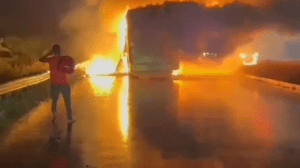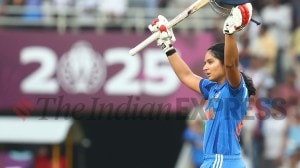A Kashmir link on paper, and now a Bangladesh hole
Arrested Harkat-ul-Jehadi Islami operative Babu Bhai’s revelation that he had delivered 10 packets of RDX a month...

Arrested Harkat-ul-Jehadi Islami (HUJI) operative Babu Bhai’s revelation that he had delivered 10 packets of RDX a month before the serial Diwali blasts in the Capital has punched holes into the Delhi Police team’s investigation that squarely blames the carnage on Kashmiri operatives of Lashkar-e-Toiba (LeT) on the basis of two satellite phone calls.
The security agencies are now looking for “Guru aka Rocky” who received 20 kg of RDX from Babu Bhai in the Walled City 10 days before the Ramzan festival of 2005. The HUJI operative, by his admission, stayed two days at Turkman Gate with a friend named Qadir before returning to Kolkata.
But till such time that “Rocky” is arrested, the official line is that it was Tariq Ahmad Dar, Mohammed Hussain Fazli and Mohammed Rafiq Shah who executed the serial blasts at the crowded markets of Sarojini Nagar, Paharganj, and a DTC bus in Gobindpuri on October 29, 2005. There are two more suspects, Ghulam Ahmed Khan and Farooque Ahmed, accused in helping the funding of the blasts.
However, the fact is that the entire investigation hinges on two calls (November 1 and 4, 2005) made by Abu Al Qama, LeT’s operational commander based in Muzaffarabad, on satellite phone to Tariq Ahmad Dar’s mobile number. In his conversations, Tariq is said to be boasting about the efficiency of the operation, (“Dilli mein kuch bazaar aise hote hai jahan camera nahin hai… There are same markets in Delhi where there are no CCTVs).” Dar claims that all the four (bombers) had returned safely and could repeat the act again (“Charon log idhar aa gaye hain — wo kehte hain ki aisa wo dubara bhi kar sakte hain”). The cops are also relying on a report published in Greater Kashmir newspaper, claiming that the phone conversation also mentioned it.
While Delhi Police has made much out of these calls, it knows that Dar was the official spokesman of LeT in the Valley since 2004. He was also the financial conduit of the LeT operatives in India after taking a 10 per cent cut in hawala transfers. Before this, Dar was a conduit for Hizbul Mujahideen (HM) in 2001-02 and was paid money into his private bank account in Srinagar from Dubai. He was picked up by the police in April 2005 and a sum of 70,000 Saudi Arabian rials was recovered. Dar used to withdraw the money through ATM, deliver to operatives and pocket his 10 per cent. Security agencies believe that Dar made this boast to Al Qama to get rewarded in cash for the Delhi blasts.
This stands to reason as despite having caught Dar, the Delhi Police have not been able to answer the following questions:
• Who were the bombers and where did they come from?
• Who got the RDX/ ammonium nitrate explosives to Delhi and who rigged up the devices?
• Where did the bombers stay or where did they escape?
Although Dar’s trial is on in court number 123 in Tis Hazari, the main accused was not in the Capital on the day of the blasts and had come to Delhi before in connection with his job as medical representative of a multinational company. Even Rafiq Shah, known to be an LeT sympathiser, was present at his college in Srinagar as five of his professors have signed an affidavit before the court to that effect. Rafiq has been identified by a witness as the bomber on board the DTC bus in Gobindpuri. In short, the investigations are incomplete and the jigsaw puzzle is far from complete.
“Phone conversations with militants abroad, inexplicable monetary transactions and visits to Delhi are all important evidence. We are investigating further and Tariq’s role would be proved,” says Karnal Singh, Joint Commissioner (Special Cell) of the Delhi Police, as he points to deposits of nearly Rs 84 lakh in Dar’s account.
According to the police chargesheet, on the fateful day, Mansoor, a Pakistani national, planted the IED in Paharganj, while Sajjad Salfi did the same outside Shyam Juice Corner in Sarojini Nagar. Mohd. Rafiq Shah planted the bomb in a DTC bus in Kalkaji. All of them then returned to Srinagar in a truck. Tariq, on behalf of Abu Ozefa, called up Kashmir News Agency and denied that LeT was behind the blasts. Mansoor and Salfi apparently have returned to Pakistan.
While there is not much corroborative evidence on record yet, it is on a similar basis — the use of mobile phone to communicate with terrorists abroad that the police have charged Mohammed Hussain Fazili. The IMEI number of Fazili’s phone had figured on the security agencies’ radar after a conversation made from it to Abu Al Qama was recorded.
“These are conspiracies of silence and at best it is only corroborative evidence that emerges. And it is only natural, we have to join the links. After all, no militant group issues identity cards to prove that a man belongs to the Lashkar or any other terrorist group,” says Rajiv Mohan, the prosecutor in the Delhi blasts case.
(Tomorrow: Mumbai train blasts and missed opportunities)
Blasts in Delhi before Diwali
Date: October 29, 2005
Terrorists struck in the Capital on the eve of Diwali on Saturday triggering three explosions in two markets (Sarojini Nagar and Paharganj) and near a bus in Gobindpuri
The arrests
Tariq Ahmad Dar of Lashkar-e-Toiba, Mohammed Fazili and Rafiq Shah — all charged for executing the blasts. But there are glaring loopholes in the case
Status of Investigation
Five arrested, one killed — and clueless about the other 38. The police files may mark the Delhi blasts as a case that has been worked out but most of the big fish remain untraceable, and evidence is hard to come by even in the case of those arrested.
Losses
Dead 53
Injured 100
Most were Diwali shoppers



- 01
- 02
- 03
- 04
- 05




























